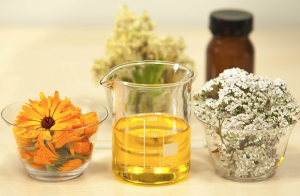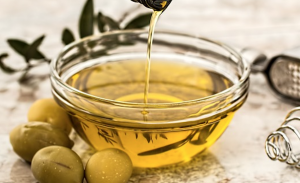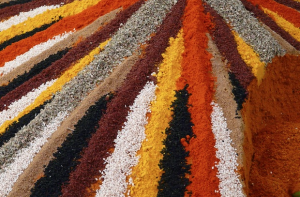How to color soap naturally
Natural colorants are amazing, but it takes time to get the process down and figure out what color you are going to get.
With natural ingredients you’ll find that a red color you have produced with infusions looks wonderful, but that color can change and look very different when mixed with the lye and then again after your soap is cured it can be a totally different color again.
So if you are looking for consistency in the color of your soap you may want to stick to oxides and micas – here is an article you may want to read Oxides and Micas
When using natural colorants keep in mind that some spices such as cinnamon, paprika and cayenne pepper can be powerful skin irritants so be careful with them.
You don’t want someone to come back saying your soap has caused them a terrible rash. The color will not be worth losing a customer.
I had that happen years ago with a bar I put cinnamon in. I no longer use cinnamon as a colorant but have replaced that one with cocoa powder, which gives the same color without being an irritant to the skin.
Some of the safest colorants for soap are from annatto seeds, alkanet root, and henna.
Plant Infusions
To make a plant infusion use powdered, chopped or ground leaves, flowers or roots of the  plant. Pour boiling water over your plant material and let it sit over night and then strain it, the liquid can be used in place of water that you add your lye to.
plant. Pour boiling water over your plant material and let it sit over night and then strain it, the liquid can be used in place of water that you add your lye to.
Colors can be really different but if you are not worried about having a difference from one batch to the next, then go ahead and give it a try.
If you are getting your color from the roots or bark of a plant, it is better to pour water over and bring to a boil and simmer for about 15 minutes.
Then cover and let it steep for another 15 minutes and strain.
You can then use this in place of the water you would normally use to add the lye to.
Plant Oils
Some of the oils that you use in soap making can also provide color to your soap, Olive oil can give you a light green color, Coconut oil gives a white or off white color, and Hempseed oil will  give your soap a brown color.
give your soap a brown color.
Other oils that will lightly tint soap are Castor, Palm, Wheat germ and Olive Oil.
Some Essential oils will not only scent your soap, but color it as well. Lemongrass, patchouli, Orange five fold, cassia bark and vanilla absolute come to mind.
Vegetable compounds can also give soap a nice natural color, chlorophyll will give you soap a shade of green, tomato will give a shade of red.
Spices and Herbs
Cinnamon, cloves, nutmeg and allspice are some spices used to color soap; they will give a light to dark chocolate color. Cayenne pepper and Paprika will give a s almon color and Turmeric and Curry powder will give shades of yellow.
almon color and Turmeric and Curry powder will give shades of yellow.
Experiment with these colors and add what you need for the desired color.
With spices it’s a good idea to mix them with some oil first because it may clump up if you were to just put it in with the soap.
I mix it with Olive Oil and then add to my pot after I’ve poured the lye/water mix in with the oils.
Colorants and Soap making
Alkanet Root – depending on the alkalinity of the soap this root will color your soap differently, if you soap has a PH of 6 – you will get shades of red, PH of 8 shades of lavender and a PH of 10 will give you shades of blue.
Annatto Seed – this will produce rich shades of yellow and orange, but these colors will fade if your soap is left in direct sunlight. So keep the soap away from the sun.
Beetroot Powder – you would think this would color your soap beet red, but it will instead give you more of a yellow squash color.
Black Eyed Susan – the stems and leaves will give you gold- orange tones and the flower will color tones of green.
Calendula Blossoms – Calendula blossoms can be ground up and added to your soap to produce yellow – orange colors depending on the blossoms.
Cocoa – shades of brown
Goldenrod – added to your lye solution fresh goldenrod flowers will color your soap light yellow
Madder Root – Madder root powder added to your soap will give a pink – red color
You may also want to read What to color my soap?
#handmadesoap #naturalsoap #makingsoapnaturally #soapmaking #soapmaking #soaps #artisansoap #bathandbody #cpsoap #coldprocesssoap #etsy #soapbase #soapcrafter #soapmaker #soaping #soapcrafting #soaphandmade #soap #giftidea #christmas #barsoap #handmadesoap #natural #organic #skincare #coldprocess #soapsupplies #colorsoap #whattocolorsoap #colorsoapnaturally
© 2017 – 2019, Tes. All rights reserved.
The option of making ones own soap is really appealing.
The commercially available soaps are so packed with unhealthy ingredients.
I am particularly interested in infusing soap with plants. Sounds very healthy.
Do you have a favorite essential oil that you add to your soap?
Would Avocado Oil be a good option?
Hi Keith, yes my favorite Essential Oil is Lemongrass, with this oil the soap takes on a light yellow color and it smells amazing. A good “wake me up in the morning scent” Avocado oil is a nice oil in soap making, using it as 20% of your oils will give a nice conditioning lather. You may want to read Properties of Soap Making Oils for more information on this and other soap making oils.
when I first saw this I thought oh this looks interesting and I am not disappointed.
Lovely site, great info. If you don’t mind I would like to link back to you in one of my next posts. I love the idea of the associate store for the soap making supplies. and the colours are perfect. Well done!! Keep it up and all the best
Vee
Thanks for the lovely comments. I’m adding new information all the time. You can certainly link back to this site. Thanks
i just checked your site and really liked what i saw and read, this is a very interesting website.
Site looks really good with lots of good info on soap and other related products. Didn’t realize soap products where that interesting. I really like the images and text that goes with it. Good job keep it up looks great.
Hi Wayne,
Thanks for having a look at the website. Glad you enjoyed it.
Your soaps look wonderful. I hate the store-bought stuff, it’s just so commercial smelling. I love the idea of using natural products on my skin and having the great smells in the bath and shower. I was wondering about how long a bar of your soap lasts? Can you get about 10 baths out of one bar?
Hi Shannon,
My soap does last a long time. The key is the oils used to make it. Some handmade soap will go mushy, but made with the right combination of oil should last. You should easily get 10 baths. Key is also to storing your soap well, if it sits in a puddle of water it will surely soak it up.
I use a soap dish that the water can drain off the soap and the soap that is not being used is stored in a cool dry place.
I find your content interesting because it shows me what ingredients are often included in natural or homemade soaps. I have been experimenting with natural soaps for awhile now because I get extremely dry skin that cracks and itches in the winter, and I have never found a commercial soap that stops that from happening. I also like the aromas of natural soaps much better.
My question after reading this page is what ingredients may help hydrate and nourish my skin rather than drying it out more? I want to try making my own soaps, but I’m concerned that what I add for color may dry out my skin. If you have any ingredient ideas or even a recipe, that would be great!
Hi Theresa the oils you use to make your soap can help to keep your skin hydrated. I do have some recipes you can try. I’ll place the link below. As for coloring your soap, you don’t have to if your worried you’ll have a reaction. Some essential oils will color your soap without having to add anything. Lemongrass and Orange come to ming.
Make Natural Soap at Home -Step by Step instructions with pictures
Castile Soap
Soap Recipes
I’m always a bit hesitant when I see colors in bath products as I feel it is unnecessary. Part of me feeling that way is because I have sensitive skin and products with perfume in have the tendency to be irritating for my skin.
However, I do have an open mind in this and I think when using natural products you could minimize the possible affects of skin irritations.
Great article!
Hi Jurgen, I guess it can depend on how much and what color a person adds. I do have a few soaps that I add no color to at all. Some of the natural scents will create a nice enough color. Lemongrass or Orange and I make and Oatmeal and Honey that I do not color. The color of the oatmeal and honey give it a nice light brown color.
This is some great information when it comes to making your own soap. I never thought to use Essential oils which both my wife and I have found to be a benefit to our health. I know lye is commonly used as a base and have wondered is there a substitute for this? Also have you ever used the Essential oil lavender and do you know if you would get both the color and wonderful aroma from it? I look forward to your reply.
Hi Chris
First you can’t really make soap without lye. I you want to create your own soap and don’t want to go the lye route you can buy what’s called melt and pour – here is a link to information on it Melt and Pour Soap another option would be to use soapwart. I have used it for washing cloths before and it works well but have never used it for a body wash so can’t say how well it would work.
As for Lavender yes I do make soap with Lavender, it is a very popular scent, but it’s oil does not add enough color to your soap oils to make a difference.
I was thinking on going more “natural” with my life since is really scaring what kind of things you find in the comercialized products on the market. I really had no clue of how to make a soap myself, I’m going to look it up on your website in the case you have a post about that.
My other concern is, like you said, the reactions that can cause some natural ingredientes. I have a 14 months old baby and I want to know if I can use “natural made by me” soaps, will that be safe for him or I should just keep using the current products at least for him? Thanks in advance.
Hello Paola, I originally started making my own skincare products because of skin irritations. The most gentle soaps have high quantities of Olive Oil, and lavender is a soothing and calming scent. Lavender is a safe oil that is safe enough to use on babies.
Below are links on how to make soap and a recipe for Castile soap
Make Natural Soap at Home -Step by Step instructions with pictures
Castile Soap Recipe
Great article and very interesting.
That you can make your own soap quote easily, as you described, is a bit mind-blowing to me.
I was always thinking it uses a lot of effort, time and chemics to make it.
And of course, money.
But to see this, is very good, because I want to make a soap with plant infusions, I bet the smell has to be wonderful.
Thanks to share this with us!
Hi Emmanuel you can make your own soap too, have a look at these step by step instructions to see if it’s something you would like to try.
Make Natural Soap at Home -Step by Step instructions with pictures
Everything has a process I can now, what I knew when I go to any shop before reading this article was to choose soup with my favorite color, never given a thought how the color comes around.
So if I want to color one, what are the other ingredients needed besides the coloring herbs , oils and spices ?
Can’t wait to color one for my self.
Hi Ngonidzashe I’ve posted below a link that will take you to directions on how to make soap and another one with soap recipes.
Enjoy
Make Natural Soap at Home -Step by Step instructions with pictures
Castile Soap Recipe
Hi Tes,
I’ve never used colorants in soap before, but this article sparked some curiosity for me. Last time I made soap, I made a huge batch of glycerin soap that lasted my family quite awhile. On the bright side, my soap was very cost effective, but on the downside, my soap was pretty boring. When I make soap again, I’d like to add something more exciting like perfumes and color. With the holidays right around the corner, I may use the tips from this article to make some exciting soaps as winter holiday gifts!
Christmas is just around the corner. I have 2 Christmas Events to attend already next weekend.
You might be interested in reading this link should you decide to do one with your soaps one day. Happy Soaping
Christmas Craft Fairs
Tes, how interesting and what a wealth of natural resources to draw upon to color soap. I was disappointed to hear cinnamon irritated the skin as I love the smell of cinnamon but also very good to know as I also don’t like rashes on my skin so thanks for the warning for this and paprika and cayenne pepper.
It is also a great tip to highlight that color may not be consistent between batches. I think this is accepted from clients if hey are aware of this through the explanation of the process that is used to create the soaps.
Isn’t it disappointing beetroot powder doesn’t come out beet red, I just love that color red.
Thanks for sharing this knowledge it is very helpful and also inspiring to try something new and derive colors from nature.
Yes it really would be nice if the beet root was that beautiful red color.
Being able to color my soap naturally sounds great. I mean, who is not attracted to nice-looking colors? Producing my own soap is something that I’ve been wanting to do, not only as a hobby but perhaps a business. And what better way to attract buyers than offering them beautiful-looking soaps.
I like shades of lavender and red but I was hoping to create soaps with shades of green too. And you mentioned olive oil and some vegetable compounds such as chlorophyll will do the job, what kind of olive oil can I use? Will any olive oil in the supermarket be okay to use? What about chlorophyll, where can I get them?
Hi for soap making you can use any grade of Olive oil and super market oil is fine, but you would probably get a better price if you order from a soap supplier. The chlorophyll is also an ingredient that you can get from a soap supplier. Here is a list of some places for you Where to buy soap making supplies